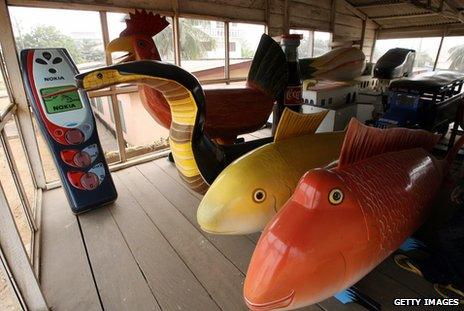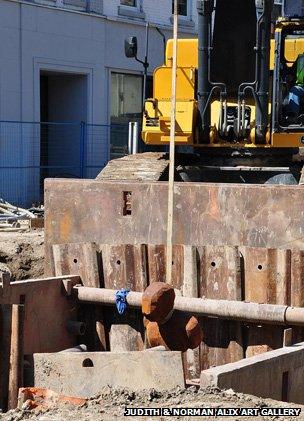Why make art no-one can see?
- Published
Joseph Ashong, known as Paa Joe, makes figurative coffins
For most artists, the creative ideal would be to have their work shown in public. Others have a more esoteric desire to not have their work seen at all. But what can this achieve?
Paa Joe crafts magnificent sculptures out of wood. He paints them and perfects them until he is happy and then he watches them get buried in the ground.
Unlike some artists who see burial as a way of adding value to their work, Paa Joe admits he finds it hard to watch his work disappear into the soil, never to be seen again.
But sadly for him, it is essential. He is a coffin maker, and one of the world's finest. Rather than the plain wooden box, Paa Joe, real name Joseph Ashong, sculpts coffins into flamboyant shapes in bright colours.
He is an artist in every sense of the word. His coffins are rooted in Ghanaian tradition. They reflect the foibles and ambitions of the deceased - an inveterate drinker may be buried in a giant beer bottle, a lothario in a coffin shaped like a reclining naked woman. He has made a Porsche coffin, a lion coffin, a pink fish coffin. He has even made coffins in the shape of a giant cocoa bean and a trainer.

Ghana's decorated coffins are an artform to be buried
"Sometimes when it's finished when people take it to put it in the grave, I am not happy," he says. "I used my idea to make that thing."
Some of the most famous artistic creations in history such as the Terracotta Army surrounding the tomb of the first Emperor Qin Shihuang and the Sutton Hoo ship burial, have been entombed to honour the dead.
And it was not intended that the Tutankhamun treasure, though exceptionally lavish and made of gold, would be seen again by humans after it was deposited in the Egyptian king's tomb.
Keeping a work from public view can actually raise its profile. Mystery is appealing.
British artist Jason DeCaires Taylor submerges his sculptures under nine metres of water off the coast of Mexico. Accessible only to scuba divers, the figures are made from marine grade cement and attract corals and seaweeds, overtime transforming into artificial reefs.
"I do quite like the hidden element, I like the idea that something exists but people don't know about it," he says.

Taylor's latest idea is to sink a sculpture to the bottom of a 500-metre deep volcanic lake in Guatemala. No-one could see it - not even the artist. He would instead have to drop it from the surface and hope for the best.
"It would be great if in hundreds of years' time when we have made the technological advances to make exploring the bottom of a volcanic lake possible, someone might discover it," he says.
Another piece currently in the planning is an installation dropped deep out at sea.
"I wouldn't tell anyone the coordinates and the sea is so vast that no-one would ever find it," Taylor says.

Burial day for Peter von Tiesenhausen's Moorings
"It's quite a controversial piece about religion and I wouldn't want it defaced, so people not knowing where it is would work well for me. Photography then becomes very important, I'd take pictures for people to see the work."
It is a quirk of human behaviour that the more difficult something is to see, the more some people want to see it.
This was the theory behind Canadian artist Peter von Tiesenhausen's decision to bury a sculpture almost four metres underground, beneath a sewer at the main crossroads in the city of Sarnia, Ontario.
The iron bust, called Mooring, was buried in 2009. In the application for permission submitted to the County of Lambton council, it was stated that the process would see the work "elevated to myth status", creating a topic of conversation and strengthening community as a consequence, the idea being that people would share the mystery of their city.
So did he feel sad to watch it disappear?
"I felt the opposite; I saw it as potential for hope and for future growth," says von Tiesenhausen. "It's like a seed, the myth around it will build. It becomes possibly greater than it would have been if people could see it, get up close and critique it."